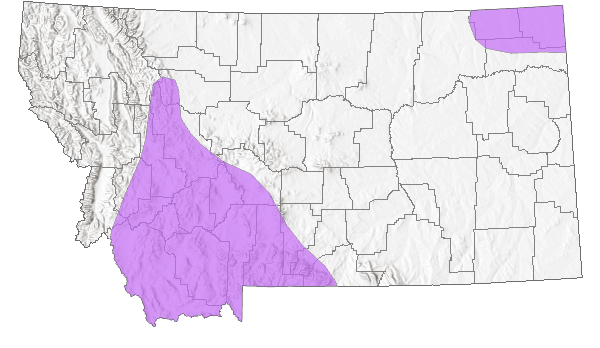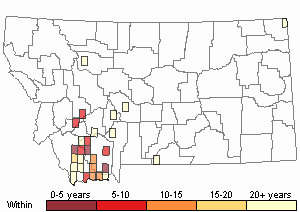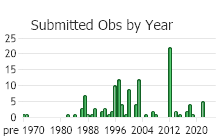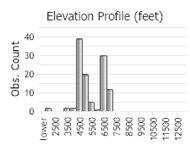View in other NatureServe Network Field Guides
NatureServe
Montana
Utah
Wyoming
Idaho
Wisconsin
British Columbia
South Carolina
Yukon
California
New York
Mealy Primrose - Primula incana
State Rank Reason (see State Rank above)
Primula incana is known from a few dozen extant occurrences in Montana, including several moderate to large populations. However, most known populations are small, and the status of several populations is uncertain. Ownership of the occupied areas is varied and includes federal, state and private lands, including several locations managed or protected for their conservation values. However, unprotected private lands host many occurrences. Cattle grazing may have some negative effects on the species including the direct effects of herbivory and trampling. The species is also vulnerable to activities that alter the hydrology of the wetlands it occupies. Continued threats and potentially declining trends, particularly in regards to habitat quality make the species' vulnerable to local extirpation.
- Details on Status Ranking and Review
Population Size
Score1 - Moderate: Generally 10,000-100,000 individuals.
Range Extent
Score0 - Widespread species within Montana (occurs in 5% or more of the state or generally occurring in 6 or more sub-basins.) as well as outside of Montana.
CommentWidespread species that occurs across more than 5% of the state (>10 sub-basins).
Area of Occupancy
Score0 - High: Occurs in >25 Subwatersheds (6th Code HUC’s).
CommentOccurrences are known from over 25 different subwatersheds.
Environmental Specificity
Score1 - Moderate: Species is restricted to a specific habitat that is more widely distributed or to several restricted habitats and is typically dependent upon relatively unaltered, good-quality habitat (C Values of 5-7).
Trends
Score2 - Moderate Declines: Species has experienced declines of 30-50% in population size, range extent and/or occupied area in the recent past (approximately 30 years).
CommentSpecific population trends are unknown, though its habit has been degraded/altered or converted to other uses throughout portions of the species' range.
Threats
Score2 - High: 31-70% of the populations are being negatively impacted or are likely to be impacted by one or more activities or agents, which are expected to result in decreased populations and/or habitat quality and/or quantity.
CommentInvasive weeds, and hydrologic and habitat alterations continue to be a problem in significant portions of the species' range.
Intrinsic Vulnerability
Score1 - Moderate Vulnerability: Specific biological attributes, unusual life history characteristics or limited reproductive potential makes the species susceptible to extirpation from stochastic events or other adverse impacts to its habitat and slow to recover.
Raw Conservation Status Score
Score
7 total points scored out of a possible 19.
General Description
Mealy Primrose is slender, tall, and heavily farinose, or occasionally efarinose. It rises up to 46 cm high, and leaves are elliptic or oblanceolate, including the petioles, which are up to 6 cm long. Blades are 0.3-1.6 cm wide with denticulate margins and gradually narrow into a broadly winged petiole. The involucral bracts are 0.5-1 cm long, oblong, densely covered with white farina, flat above, and saccate or gibbous at the base. The umbels are capitate, 7-19 flowered, and the pedicels are short and 0.3-0.9 cm long. Flowers are homostylous. The calyx is green, heavily farinose, cylindrical, obscurely ribbed, and 0.4-0.7 cm long; it is divided up to one third its length by lanceolate teeth that are covered with capitate 3-4 celled glands. The corolla is lavendar with a yellow throat. The limb is 0.4-0.8 cm wide, emarginate, and is a tube that is equal to or slightly longer than the calyx. Stamens are ca. 1 mm long and located in the upper portion of the corolla tube. The stigma is capitate and located adjacent to the anthers. The capsule is cylindrical to slightly elliptical, 0.2-0.3 cm wide, and 1.5-2 times the length of the calyx. Seeds are brown, reticulate, ca. 0.2 mm long.
Phenology
Flowering occurs in May to June.
Diagnostic Characteristics
Primula parryi occurs in rocky habitats near or above treeline. The similar P. alcalina is found in the same habitat, but it has white flowers, and its leaves have little or no mealy covering, even below. In addition, the anther filaments of P. alcalina are of two different lengths.
Species Range
Montana Range
Range Descriptions

 Native
Native
Range Comments
From Utah and Colorado north to Alaska and east to Quebec. Rare in southern Utah, Colorado, Wyoming, North Dakota,and Montana, more common in Canada from British Columbia east to western Manitoba, rare in the Yukon and Alaska (where it is limited to stable flood plains along rivers).
Observations in Montana Natural Heritage Program Database
Number of Observations: 131
(Click on the following maps and charts to see full sized version)
Map Help and Descriptions
Relative Density

Recency



 (Observations spanning multiple months or years are excluded from time charts)
(Observations spanning multiple months or years are excluded from time charts)
Habitat
In southwestern and north-central Montana, mealy primrose has been found in saturated, often calcareous wetlands. Dominants or common associates include Carex simulata, C. nebrascensis, Juncus balticus, Agrostis stolonifera, Muhlenbergia richardsonis, Calamagrostis stricta, and Eleocharis pauciflora. In Sheridan County it was restricted to seep habitat with marl deposits beside an alkali lake. The most common associated species there were Juncus balticus, Scirpus pungens, Triglochin maritimum, and Potentilla anserina.
National Vegetation Classification System Groups Associated with this Species
Wetland and Riparian
Alkaline - Saline Wetlands
Alpine Riparian and Wetland
Riparian Shrubland
Wet Meadow and Marsh
Ecology
Mealy primrose in Montana appears to be restricted to wet meadow habitats with relatively stable water tables. Associated streams have a fairly constant water flow; i.e., permanent flows with little flooding in spring. Soils remain moist to saturated throughout the growing season, but there is little or no inundation.
Primula incana is often found growing on the sides of hummocks where the density of overtopping vegetation is reduced. Hummock habitats are moist without being wet and are more open than wetter microhabitats dominated by sedges and rushes.
The effects of livestock grazing on
Primula incana appear to be both positive and negative. Leaves of
P. incana are all at ground level, so herbivory by livestock can eliminate seed production but will not kill the plant or remove significant photosynthetic tissue. Grazing can partially remove the overtopping canopy of grasses and sedges, allowing more light to reach
P. incana rosettes. Furthermore, trampling by livestock undoubtedly is instrumental in causing hummocks, often the most productive habitat for
P. incana. No significant association was found between grazing pressure and the abundance of the closely related
P. alcalina in an Idaho study (Muir and Moseley 1994), and grazing was positively associated with the persistence of
P. farinosa, a closely related European species (Lindborg and Ehrlen 2002).
POLLINATORS The following animal species have been reported as pollinators of this plant species or its genus where their geographic ranges overlap:
Bombus bifarius,
Bombus flavifrons,
Bombus nevadensis,
Bombus sylvicola,
Bombus insularis, and
Bombus kirbiellus (Macior 1974, Miller-Struttmann and Galen 2014).
Management
Wetland habitats of mealy primrose can be adversely affected by water diversions that lower water tables. The wet meadow habitat can also be affected by livestock grazing. Livestock congregate in the vicinity of wetlands in summer for the lush, succulent vegetation and proximity to water. Mealy primrose is low to the ground and may benefit by having the canopy of dominant graminoids reduced. Trampling by cattle may also benefit this species by creating mesic microhabitats on the tops and sides of the hummocks. However, livestock grazing in the uplands can reduce vegetal cover, thereby increasing runoff, flash flooding and channel downcutting. The lowered water table that accompanies downcutting causes a loss of wetland habitat, which could result in population declines for this plant.
Stewardship Responsibility
Threats or Limiting Factors
STATE THREAT SCORE REASON
Reported threats to Montana's populations of Mealy Primrose include actions that either prevent disturbance or result in extreme disturbance to its habitat or manipulate hydrology (MTNHP Threat Assessment 2021). Livestock grazing that removes too much vegetation can prevent seed production, trampling, and soil compaction. Plants often grow on the tops and sides of hummocks within wet meadows or wetlands. With a lack of disturbance plants become outcompeted by other vegetation. Hummock smashing removes these hummocks, directly removing both plants and its micro-habitat. Livestock grazing that removes too little vegetation allows other plants to out-compete Mealy Primrose. Actions that destabilize the water table or result in a loss of wetland habitat negatively impact Mealy Primrose. Hydraulic alteration that reduces surface water can change community composition and negatively impact the plant. Non-native thistles are reported as a threat at some populations administered by the BLM Dillon Field Office.
References
- Literature Cited AboveLegend:
 View Online Publication
View Online Publication Macior, L.M. 1974. Pollination ecology of the Front Range of the Colorado Rocky Mountains. Melanderia 15: 1-59.
Macior, L.M. 1974. Pollination ecology of the Front Range of the Colorado Rocky Mountains. Melanderia 15: 1-59. Miller-Struttmann, N.E. and C. Galen. 2014. High-altitude multi-taskers: bumble bee food plant use broadens along an altitudinal productivity gradient. Oecologia 176:1033-1045.
Miller-Struttmann, N.E. and C. Galen. 2014. High-altitude multi-taskers: bumble bee food plant use broadens along an altitudinal productivity gradient. Oecologia 176:1033-1045. MTNHP Threat Assessment. 2021. State Threat Score Assignment and Assessment of Reported Threats from 2006 to 2021 for State-listed Vascular Plants. Botany Program, Montana Natural Heritage Program, Helena, Montana.
MTNHP Threat Assessment. 2021. State Threat Score Assignment and Assessment of Reported Threats from 2006 to 2021 for State-listed Vascular Plants. Botany Program, Montana Natural Heritage Program, Helena, Montana.
- Additional ReferencesLegend:
 View Online Publication
View Online Publication
Do you know of a citation we're missing? Culver, D.R. 1994. Floristic analysis of the Centennial Region, Montana. M.Sc. Thesis. Montana State University, Bozeman. 199 pp.
Culver, D.R. 1994. Floristic analysis of the Centennial Region, Montana. M.Sc. Thesis. Montana State University, Bozeman. 199 pp. Kelso, S. 1987. Systematics and biogeography of the arctic and boreal species of Primula. Ph.D. dissertation. University of Alaska. Fairbanks, Alaska. 53 pp.
Kelso, S. 1987. Systematics and biogeography of the arctic and boreal species of Primula. Ph.D. dissertation. University of Alaska. Fairbanks, Alaska. 53 pp. Kelso, S. 1991. Taxonomy of Primula sects. Aleuritia and Armerina in North America. Rhodora 93(873): 67-99.
Kelso, S. 1991. Taxonomy of Primula sects. Aleuritia and Armerina in North America. Rhodora 93(873): 67-99. Kelso, S. 1992. The genus Primula as a model for evolution in the Alaskan flora. Arctic and Alpine Research 24(1): 82-87.
Kelso, S. 1992. The genus Primula as a model for evolution in the Alaskan flora. Arctic and Alpine Research 24(1): 82-87. Lesica, P. and J. Vanderhorst. 1995. Sensitive plant survey of the Sage Creek area, Beaverhead County, Montana, Dillon Resource Area, Bureau of Land Management. Unpublished report to the Bureau of Land Management. Montana Natural Heritage Program. 36 pp. plus appendices.
Lesica, P. and J. Vanderhorst. 1995. Sensitive plant survey of the Sage Creek area, Beaverhead County, Montana, Dillon Resource Area, Bureau of Land Management. Unpublished report to the Bureau of Land Management. Montana Natural Heritage Program. 36 pp. plus appendices. Lesica, P., M.T. Lavin, and P.F. Stickney. 2012. Manual of Montana Vascular Plants. Fort Worth, TX: BRIT Press. viii + 771 p.
Lesica, P., M.T. Lavin, and P.F. Stickney. 2012. Manual of Montana Vascular Plants. Fort Worth, TX: BRIT Press. viii + 771 p. Lesica, P., M.T. Lavin, and P.F. Stickney. 2022. Manual of Montana Vascular Plants, Second Edition. Fort Worth, TX: BRIT Press. viii + 779 p.
Lesica, P., M.T. Lavin, and P.F. Stickney. 2022. Manual of Montana Vascular Plants, Second Edition. Fort Worth, TX: BRIT Press. viii + 779 p. Lindborg, R. and J. Ehrlen. 2002. Evaluating the risk of a perennial herb: demographic data versus historical records. Conservation Biology 16: 683-690.
Lindborg, R. and J. Ehrlen. 2002. Evaluating the risk of a perennial herb: demographic data versus historical records. Conservation Biology 16: 683-690. Muir, P.S. and R.K. Moseley. 1994. Responses of Primula alcalina, a threatened species of alkaline seeps, to site and grazing. Natural Areas Journal 14:269-279.
Muir, P.S. and R.K. Moseley. 1994. Responses of Primula alcalina, a threatened species of alkaline seeps, to site and grazing. Natural Areas Journal 14:269-279.
- Web Search Engines for Articles on "Mealy Primrose"





